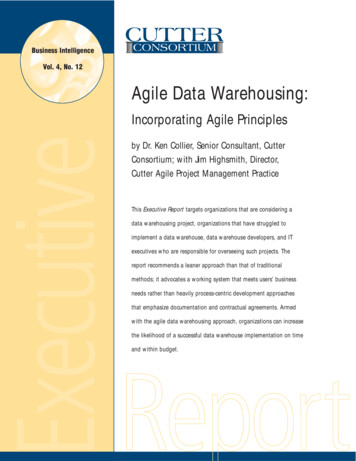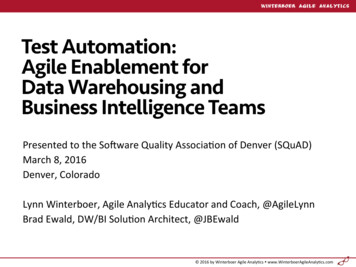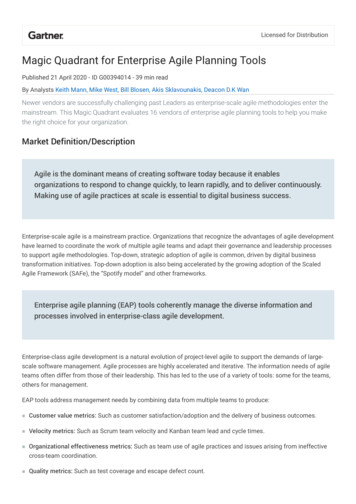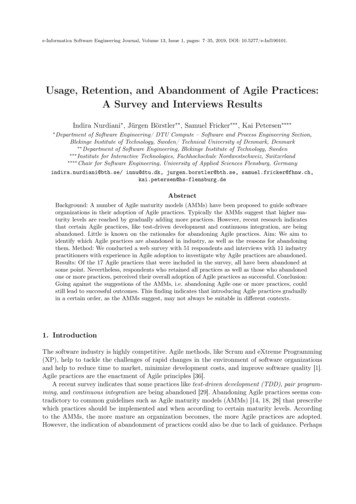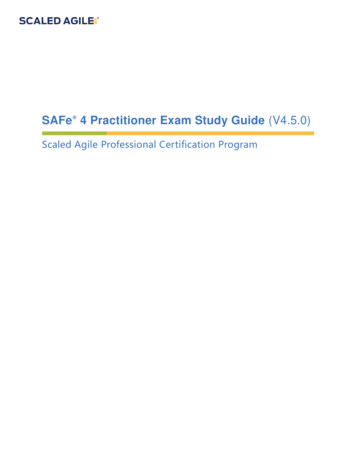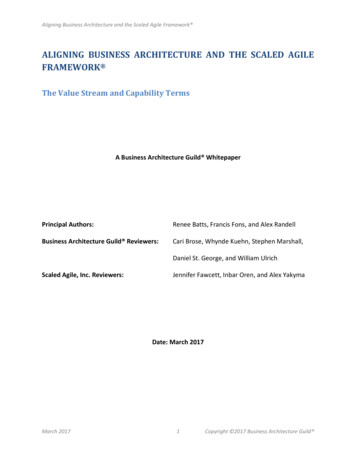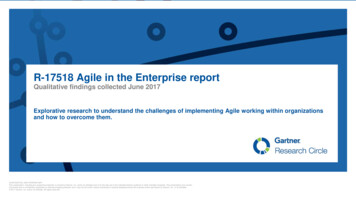
Transcription
R-17518 Agile in the Enterprise reportQualitative findings collected June 2017//Explorative research to understand the challenges of implementing Agile working within organizationsand how to overcome them.CONFIDENTIAL AND PROPRIETARYThis presentation, including any supporting materials, is owned by Gartner, Inc. and/or its affiliates and is for the sole use of the intended Gartner audience or other intended recipients. This presentation may containinformation that is confidential, proprietary or otherwise legally protected, and it may not be further copied, distributed or publicly displayed without the express written permission of Gartner, Inc. or its affiliates. 2017 Gartner, Inc. and/or its affiliates. All rights reserved.
Thank you noteThank you for contributing to our research efforts by participating in the online chat about howorganizations overcome cultural challenges on their path to success in agile development.The results show that. There are several potential benefits shifting to an Agile workplace However, there are multiple organizational challenges to be overcome first In order for Agile to work, a culture shift is required– A culture of trust, with freedom to experiment and try new approaches, is essential for Agile to be successful– Close collaboration with end users– Focusing on customer satisfaction metrics instead of traditional metricsWe hope you find value in this summary of the results, which can be accessed by INSERT LINK.Sincerely,Claire, Gartner Research Circle,on behalf of Mike West and William Holz2 2017 Gartner, Inc. and/or its affiliates. All rights reserved.
Research leadsAdd profilepicturefromG@WMike WestResearch Director,Web Mobile & Application DevelopmentMike.West@gartner.comMike West covers development methodologies,with aprimary focus on the adoption,organizational impact and governance of agile,scaled agile, and Web-scale development andcontinuous deployment using DevOps approaches.Prior to joining Gartner, Mr. West worked as adeveloper and manager at financial services (JohnHancock and Fidelity Investments) and high-tech(Apple) companies. Mr. West has extensiveexperience as a developer, as a manager and asan analyst in application development tools,methods and platforms.3 2017 Gartner, Inc. and/or its affiliates. All rights reserved.Add profilepicturefromG@WWilliam Holz,Research Director,App PlatformWilliam.holz@garner.comBill Holz covers a range of technical topics, includingsoftware development methodologies (focus on agile) andWeb development.Mr. Holz has more than 28 years of industry experiencemainly focused on Web and mobile development projectsand adoption of agile development methodologies. Prior tojoining Gartner, Mr. Holz led the Application Developmentand Enterprise Architecture team at the ProjectManagement Institute (PMI) where he led nization of the application portfolio, delivery of PMI'sfirst mobile application, formation of an enterprisearchitecture team, and acquisition of Gantthead(projectmanagement.com).
Research objectives and hypothesisHypothesisOrganizations will need to adopt different waysto build systems requiring changes for both ITand business peopleObjectivesExamine the most common stumbling blocks faced byorganizations adopting agile which is aroundorganizations’ ability to change the culture and howsuccessful organizations overcame their constraints. 4 2017 Gartner, Inc. and/or its affiliates. All rights reserved.How agile teams overcome the organizationalculture challenge?What were the necessary culture changes/transformations for organizations that adoptedagile?What are the key processes and practices that ledto success?
Approach and sampleMethodologyRespondents’ profile2 x online chat sessionsWe spoke to a total of 11 Research Circle panelists who work in arange of industries in different regions and use Agile in varying degreesPanelists participated in 60-minute onlinefocus groups with 4-6 other ResearchCircle panelists, where they were asked toshare their thoughts and experiences onAgile in the enterpriseNorth America panelists: 8EMEA panelists: 3Fieldwork datesUse Agile for some of theirapp developments: 6Use Agile for most of theirapp developments: 3Thursday, June 1st 2017Blend of IT & businessfocused panelists: 2IT focused panelists: 9Use Agile for all of theirapp developments: 28 panelists feel Agile development in their organization has been successful, 1feels it has not been very successful, and 2 think it’s too early/difficult to tell5 2017 Gartner, Inc. and/or its affiliates. All rights reserved.
Overcomingorganizationalcultural challengesto Agile6 2017 Gartner, Inc. and/or its affiliates. All rights reserved.
SummaryThere are several potentialbenefits shifting to an Agileworkplace 7Agile offers rapid feedback,quick iterative refinement anddirect feedback from the enduser leading to products bettersuited for the customer.At the same time, developmentteams work closely together toshare best practices and sparknew thinking. 2017 Gartner, Inc. and/or its affiliates. All rights reserved.However, there are multipleorganizational challenges tobe overcome first Organizations often struggle tocome up with a sharedunderstanding of what Agile isand how it works.New approaches are neededfor budgeting, as well as clearprioritization of tasks to preventbacklogs from piling upChanging too much, too sooncan also be a major challengeIn order for Agile to work, aculture shift is required A culture of trust, with freedomto experiment and try newapproaches, is essential forAgile to be successfulClose collaboration with endusers.Focusing on customersatisfaction metrics instead oftraditional metricsOptimized tools andchanges in HR/Governancewill future-proof Agile Optimized tools that allow moretime for developing ideas andautomated, AI-based QAtesting will increase efficiencyGovernance and centralizedmanagement will need toadjust to accommodate AgileHR teams also need tounderstand Agile better
There are several benefits of adopting Agile practicesRapid feedbackIterative refinementBetter outcomesCollaborationThe nature of Agile andassociated project teamstructures meancommunications travel topto bottom quicklyAs each Agile sprint isshort, it means thatorganizations can quicklylearn and adapt fromexperiences, and canseek to refineCustomer feedback leadsto final products thatprovide customer valueDevelopment teams workclosely together to sharebest practices and sparknew thinking“Devs need to learn how tothink long term within aniterative cycle. Short sprintsdoesn't mean you can't buildsophisticated architecturesover time.”“By delivering what thebusiness asks for quickly,they've realized that wasn'twhat they really wanted andwe were able to adjust,usually in the next sprint, todeliver something they didn'toriginally ask for but wasmore in tune with what theyreally wanted.”“The key advantage is whendev teams interact closelyand produce demos.”“Rapid feedback has workedvery well. Highly visiblestatus/progress also.Changing external processesto work well with Agile isalways challenging.”8 2017 Gartner, Inc. and/or its affiliates. All rights reserved.
But for Agile to be successful there are challenges and risks to overcomeXXXXXXA clear,shared common understanding ofxxxxwhat Agile isBusiness stakeholders have new xxxxresponsibilitiesfor articulating & justifyingthe business outcomes“The first thing is to understand Agile.”“The business doesn't like dealing with a long listof backlog items and prioritizing because theyusually want it all and they want it now.”XXX xxxxRequiresa new approach for budgeting“Budgeting is an issue. usually, managementwants to know what they are getting for theirmoney and how much it is going to cost.”9 2017 Gartner, Inc. and/or its affiliates. All rights reserved.XXXChangingtoo much, too soon can be axxxxdisaster “What hasn't worked for us it trying to do allprojects at once.”
Making the transition towards Agile developmentXXXStart small and then expand it.“Start with a small dedicated groupand project to work out the processthat works for you in yourenvironment and then expand it.I will second that doing all projects atonce does not work or changing allyour processes to agile at once start small and take it in steps”“It is too easy to throw the baby outwith the bath water. In other words,too easy throw out best practices likeproject planning, architecture, anddata modeling. Agile does notprevent best practices, but developersare quick to take short cuts.” 10XXXAdditionally – organization specificxxxx best practices needadjustments. Think before youdiscard them.xxxx 2017 Gartner, Inc. and/or its affiliates. All rights reserved.XXX Ensure that you make Agilexxxxresults visible to the wholeorganization.“Adopting agile needs a mindsetchange, start in areas where thechanges are dynamic and benefitscan be demoed to the business.”
Required stepsAgile organizationaltransformation11 2017 Gartner, Inc. and/or its affiliates. All rights reserved.
There are 3 key hurdles to overcome in order for Agile to be successfullyadoptedXXX AGILEMINDSET & THExxxxWATERFALL LEGACYXXX MANAGEMENTxxxx12 2017 Gartner, Inc. and/or its affiliates. All rights reserved.SUPPORTXXX xxxxTIMEAND PERSERVERANCE
The legacy mindset is the primary, initial barrier to Agile – developers andcustomers need to learn to work in a new wayXXXEmployeesneed compelling xxxxreasons to believe in Agilebefore they can get behind it“I've had a small number of peoplemove to other positions rather thanadapt to the Agile processes, but thathasn't happened for years now”13 2017 Gartner, Inc. and/or its affiliates. All rights reserved.XXXXXXDevelopershave to change xxxxthe way they work to besuccessfulEqually, xxxx customers have tochange the way they work(and when they do they like it)“For us the challenge has mainlybeen certain people, rather thanroles, but in general developershave been very willing to adapt aslong as they know that we are notcompromising on quality and designconsiderations.”“Our customers like Agile becausethey get demos every 2-to-6 weeks.They get to provide feedback andsee it implemented. They quicklydiscover when a project is lackingbehind its predictions.”
Plus, letting go of the legacy of Waterfall is a significant challenge14“We worked in phases, started with just doingsmall waterfall releases, then took onestimating, and then went on to integrating withproduct management and backlog modifyingour processes along the way. We let theengineers executing the work write theprocesses first and then had our processengineers adapt them”“Adopting Agile to fit your needs and process iskey, you just can't open the book and say this iswhat we are doing and how we are doing it.”“We originally had to promise deliverables oneyear in advance and then we would do Agileand deliver what the customer wanted.Management has now adapted to a quarterlyschedule for approving deliverables.”“This was a tougher thing than I expected atfirst. Developers were so used to the scheduledeath march that they always assumed fastwas the way to go and that it was ok to say itwould take longer to do it right.” 2017 Gartner, Inc. and/or its affiliates. All rights reserved.
From a top-down perspective, management needs to be fully committed anddrive the change“Having a strong business PM committed towards thesolution on a day to day basis is keyonce this is established, he/she can be the changeagent driving the business transition.”XXXCulture xxxx change requires strong leadership andchange agents“It [empowerment] tends to be over-used and underpracticed.management throws it around like it is amagic bullet for employee satisfaction, yet very seldomreally understands that it means bottom-up decisionmaking and actions”XXX Agilexxxx requires management support anddelegation to give teams autonomyXXX“HR Resource profiles havebeen changed.”15 2017 Gartner, Inc. and/or its affiliates. All rights reserved.Thisalso includes management roles in finance, xxxxHR and other areas of the business
But, these changes will require time and persistence to embed effectively16Employees (not just in IT, but allareas) may initially resist Agile andstruggle to adaptTo get employees on-board, theyneed to see the benefits – whichcan take timeOnce customers are clear on whatAgile can deliver – they are alsoenthused, which can improvesatisfaction levels“We're starting to see development andother technical staff working moreclosely with business users. This isn't abad thing, but it's caused somemiscommunications and slow-downswhile people get used to it.”“In my current role and in my previousrole with a larger, internal developmentteam I've never seen Agile done easily.I think it represents a huge sea changefor an organization of any appreciablesize. Not to say it can't be done ordoesn't have benefits, it's just slow andchallenging.”“Our customers are driving the move toAgile because they love theinvolvement and they get products thatwork better for them. Even though it ishard for IT to measure and report on allthe facets of customer satisfaction, ourcustomers are happy and want Agile.” 2017 Gartner, Inc. and/or its affiliates. All rights reserved.
Process andpractice evolutions17 2017 Gartner, Inc. and/or its affiliates. All rights reserved.
Teams working with Agile need to be adaptive, flexible, self-managing - with aclear view of the tasks that need to be prioritizedBeing adaptiveKeeping it simpleEmpowering teamsSetting prioritiesBeing adaptive is key inmaking Agile work –teams need to be flexibleand ready to respond tochange quicklyIt is necessary to keepAgile simple, withoutoverly complicating aconcept that is rooted in abasic, simple philosophyTeams that work withAgile need to be selfmanaging and able towork autonomously,taking the initiative whennecessaryPrioritizing tasks anddetermining whichaspects to focus on iscrucial in Agile“This is key because the teamis now self empowered.”“There is a need to determinethe big stories that you work onand maybe the first level ofdrilling down inside thosestories.”“The change comes fromallowing people to work in anAgile/flexible manner wheremembers' opinions matter.”18 2017 Gartner, Inc. and/or its affiliates. All rights reserved.“Agile is indeed simple howeversometimes hyped probably.”
Shifting from a culture of control to one of trust is a key requirement for Agileto work“Teams need to deliver things thebusiness needs and that impliessome work up front to determinethe big stories that you work on.”“QA should be acollaborative endeavor andnot the code police.”19 2017 Gartner, Inc. and/or its affiliates. All rights reserved.Creating a sharedvision with everyonehaving aresponsibility forshaping it, teamsworking incollaborationIn certain instances,there might be aneed to maintainmore direct controlto ensure projectsuccess, so somediscretion is required“It's very difficult for directorswhose heads are on the block forsuccess to release enough oftheir decision-making authority fortrust or empowerment to happen”Ensuring teammembersunderstand thedesired businessoutcome and findtheir solution“Trust provides the team the abilityto suggest how they could meet abusiness need instead of being toldhow to meet that need.”“Control vs. Trust.there's still a fair amount of truth to the adage "when everybody isresponsible, nobody is responsible".not all people and not all teams are well-suitedto an agile methodology or that level of trust/responsibility, you have to figure outwhere to put your trust and where to maintain more direct control”
Working in collaboration with customers keeps focus on the business outcomeClosely working with the end users in mind can result in a range of benefits20VisionClarityCollaboration with the end usersensures the amount of reworkneeded is minimized, andcompleting the work in smallerincrements helps maintain focus oncustomer goalsClosely working with end usersensures that: Everyone is constantly remindedof the end goal End users can provide a cleardefinition of what they want“Our customers like agile because they getdemos every 2-to-6 weeks. They get toprovide feedback and see it implemented.”“Not possible to work on the mostimportant thing first and deliver true valueto the user if the user is not part of definingthis.” 2017 Gartner, Inc. and/or its affiliates. All rights reserved.End users’ vision mightchange, so teams usingAgile need to take thisrisk into account
Moving from productivity to customer satisfaction metrics requires a cultureshift, but helps the team understand how to improveMany feel that switchingXXXto Agile would, inturn, also require a shift from productivity xxxxoriented metrics to customer satisfactionmetrics. This is seen as a key prerequisitefor Agile to become a successful practice.“This is a culture shift, really. If you don't measurecustomer satisfaction you don't have the motivation tosupport and utilize the feedback loops.”“It is harder to measure customer success than being ontime and on budget.”Customer satisfaction metrics could: Be measured at every release – forinstance by using Net Promoter Score Provide feedback loops Give the team motivation andunderstanding of how to improve21 2017 Gartner, Inc. and/or its affiliates. All rights reserved.“I have recently seen the effect on customers liking whatthey are getting; presentations to upper managementhave the business saying that what we are doing iscritical to their future and success.”
Placing emphasis on doing things right rather than fast is challenging butnecessary, as stakeholders expect both speed and high qualityPeople feel that this [speed] is acore requirement for Agile to besuccessful, but delivering highquality work is the main priority“Our capex processes are so slow,agile would out-pace the availablefunding and other componentsnearly every time.that's somethingwe need to changeorganizationally”“We want to shift the conversationto investment, not cost.”22 2017 Gartner, Inc. and/or its affiliates. All rights reserved.Focusingthe discussion oninvestment rather thancost is key – especiallyupfront investmentThis can bechallenging, asstakeholderswant both –fast and rightProductivity in agilearises from reducingthe amount ofrework, as the focusis on completing themost important tasksfirst“This was a tougher thing than Iexpected at first. Developers wereso used to the schedule deathmarch that they always assumedfast was the way to go and that itwas ok to say it would take longerto do it right.”“I really believe in doing things rightand not just fast. This is a very hardone to get our developers to do.After doing this for ten years, ourculture has moved to fast andexperimental. We need a coursecorrection, but it is very hard toshift.”“Doing things right tends tomean doing things fast[er] asyou're not doing a lot of rework.”
People feel that moving from specification to experimentation is a risk worthtaking, as it could lead to important breakthroughsLearning how to moveaway fromspecification and moretowardsexperimentation isimportant insuccessfullyimplementing AgilePeople feel that Agilegives them theopportunity toexperiment with moretechnologies, but theywant to make surethat experimenting willbring a real benefit tothe project“Often people would do nothing rather thansomething for fear of failure.”23 2017 Gartner, Inc. and/or its affiliates. All rights reserved.Although they feelexperimenting issometimes done forthe sake of it, they seethe merit of it andacknowledge thatimportantbreakthroughs comethrough this process“When you have good ideas and you allowpeople to pursue them you get results thatsurprise people sometimes. a fewsuccesses can lead to more freedom to takechances and try things out.”
The future of Agile24 2017 Gartner, Inc. and/or its affiliates. All r
Research Director, Web Mobile & Application Development Mike.West@gartner.com. Bill Holz covers a range of technical topics, including software development methodologies (focus on agile) and Web development. Mr. Holz has more than 28 years of industry experie


